Artists
‘I’m Truly Inside the Flower’: Why Rising Artist Kate Bickmore Is Reimagining Victorian Floral Painting
In the artist’s New York gallery debut at Chart, her carnivorous plants upend the agendas of their 19th-century inspirations.
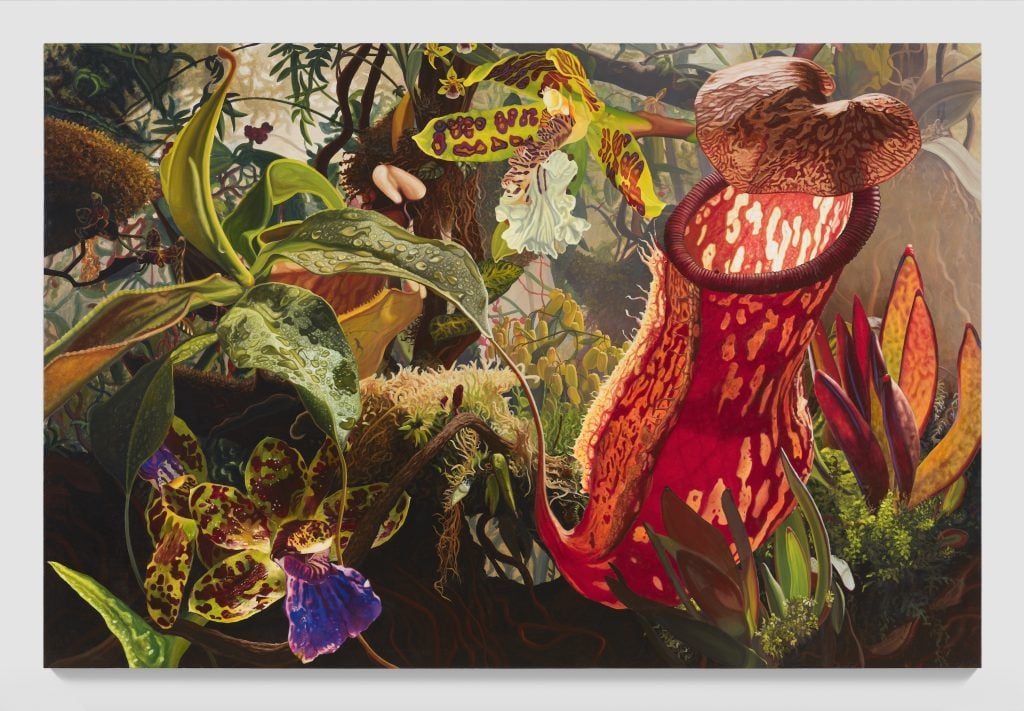
In the artist’s New York gallery debut at Chart, her carnivorous plants upend the agendas of their 19th-century inspirations.

J. Cabelle Ahn

A kaleidoscope of dewy petals and verdant vines engulfs visitors to “On the Precipice,” the British-American artist Kate Bickmore’s first solo show in New York, at Chart (through October 19). A 2019 graduate of London’s Royal College of Art, Bickmore creates large-scale florascapes in oil paint using a multi-step process that includes firsthand study of live specimens and the creation of intricate dioramas. Her practice captures the sensory totality of a floral ecosystem while echoing the bodily connection she feels to nature as a queer woman.
“In terms of my queer identity, I love what happens when I paint flowers larger than me,” Bickmore said in a recent conversation. “As I’m painting, I’m truly inside the flower. I don’t see the edges of the canvas. I’m fully immersed and present within the flower—it contains me.”
Bickmore’s subject matter naturally places her in a long lineage of artists who have used flowers as pathways to larger cultural issues, ranging from the economic metaphors of Dutch flower pieces and the Modernist visual testament of Henri Fantin-Latour’s bouquets to the feminine subversions of Georgia O’Keeffe’s enlarged buds and the raw sexuality of Robert Mapplethorpe’s floral photographs. Yet her subject matter also draws from a specific moment in 19th-century Victorian flower painting. The depth of Bickmore’s rebellion only becomes clear if one unpacks her particular allusions to that moment—and one fitting way is by tracing the historical roots of three flower types in her work.
The Pitcher Plants of Marianne North
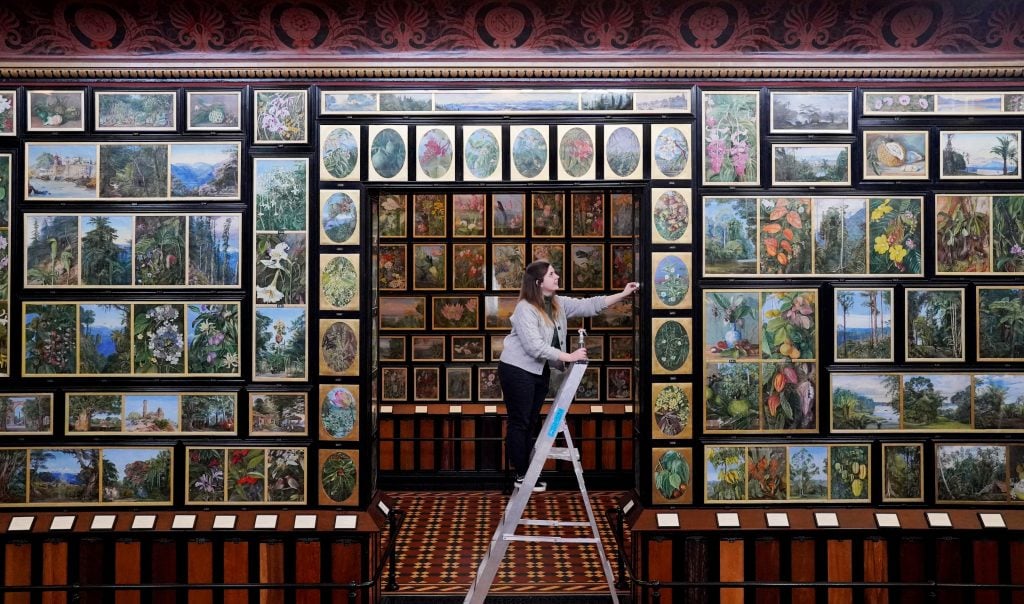
Gallery and Exhibition Assistant Shannon Towell undertakes part of the cleaning and maintenance project at Kew Gardens’ Marianne North Gallery, Kew.
One of Bickmore’s primary references is Marianne North (1830-90), a Victorian flower painter who traveled the world in search of botanical specimens. North’s works prioritized atmosphere and habitat, distinguishing them from the often-lifeless cross-sections of plants that defined the preceding centuries of naturalist art. She is best remembered today for the namesake gallery at Kew Gardens that she conceived and designed in 1882. One day after its opening, The Times praised the gallery for combining “in an almost unprecedented degree the qualities of the enthusiastic traveler and the accomplished artist.”
However, North’s legacy has been complicated by contemporary scholarship. The historian Michelle Payne has pointed out not only the virulent class and racial prejudices prominent in the artist’s travel writings but also that North never journeyed outside the territories of the British empire (or at least the locales where Britain maintained significant economic and diplomatic influence). Both revelations embed her entire artistic practice within systems of exploitation.
The virtues of North’s work sometimes camouflaged these imperial impositions. Like many naturalists of the era, she alerted Western science to new flora through her paintings. She even lent her name to several specimens, including the Nepenthes northiana, a carnivorous pitcher plant endemic to Borneo. Although nearly all of North’s flower pieces were understood to be made in situ, she actually painted her pitcher plants from cut specimens collected for her by one Alfred Hart Everett, an aspiring British naturalist who later managed a regional mercury mine under a British charter. According to her journals, North arranged these cut plants on the balcony of her residence, disguising their ersatz origins in her celebrated paintings at Kew.
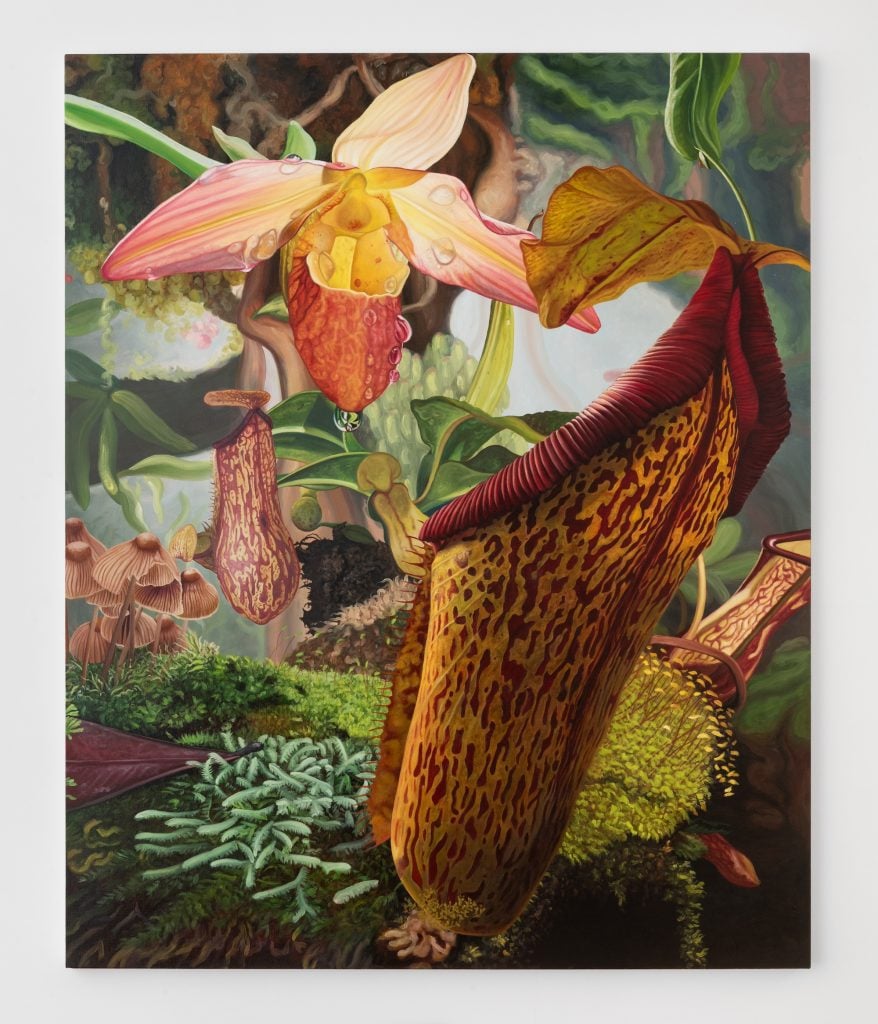
Kate Bickmore, Sublime Intervention of Chlor-Ophelia (2024). Courtesy of the Artist and CHART. Photo: Adam Reich.
Almost 150 years later, Bickmore offers somewhat of a corrective to North’s legacy through her oversized renderings of Bornean pitcher plants. “When I depict carnivorous plants on a large scale, it really feels like they could consume the viewer, so in that sense, the viewer becomes the object of desire, rather than the plant,” she says. In other words, whereas North extended Britain’s colonial system by extracting native flowers for passive digestion by her audience, Bickmore’s oversized carnivores invert the power dynamic.
The transparency of her process also separates Bickmore from the problematic past. Similar to North and other 19th-century naturalists, she first travels to study living plants—whether in botanic gardens or the remote cloud forests of Borneo—then rearranges specimens in the studio to optimize her compositions. However, Bickmore is open about the fictive aspects of her work, in turn underscoring the hidden agendas of her forebears.
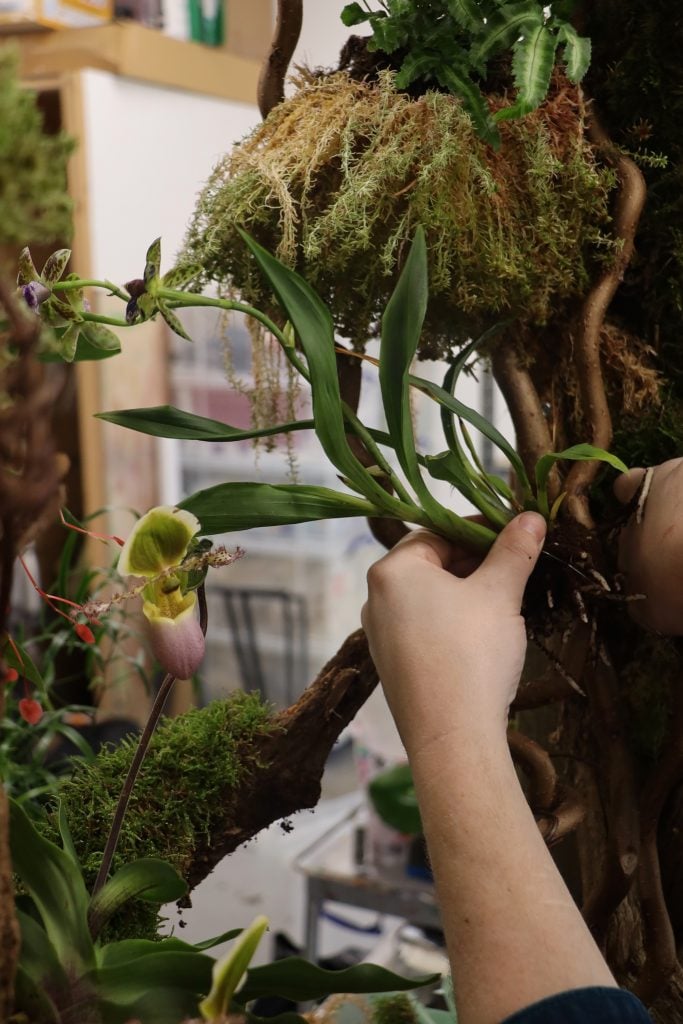
The florist Samuel Thomas arranging the diorama. Photo courtesy of Kate Bickmore.
Every work in “On the Precipice,” for example, extends from the bespoke dioramas of living flowers made by Bickmore and the florist Samuel Thomas. In most cases, she uses these constructed environments to shoot reference photographs that inform her painting process. But this exhibition also includes two miniature versions of the dioramas, presented as standalone installations visible through peepholes in a wall of the gallery’s basement. Their fantastical placement reinforces their artifice.
The Orchids of Martin Johnson Heade
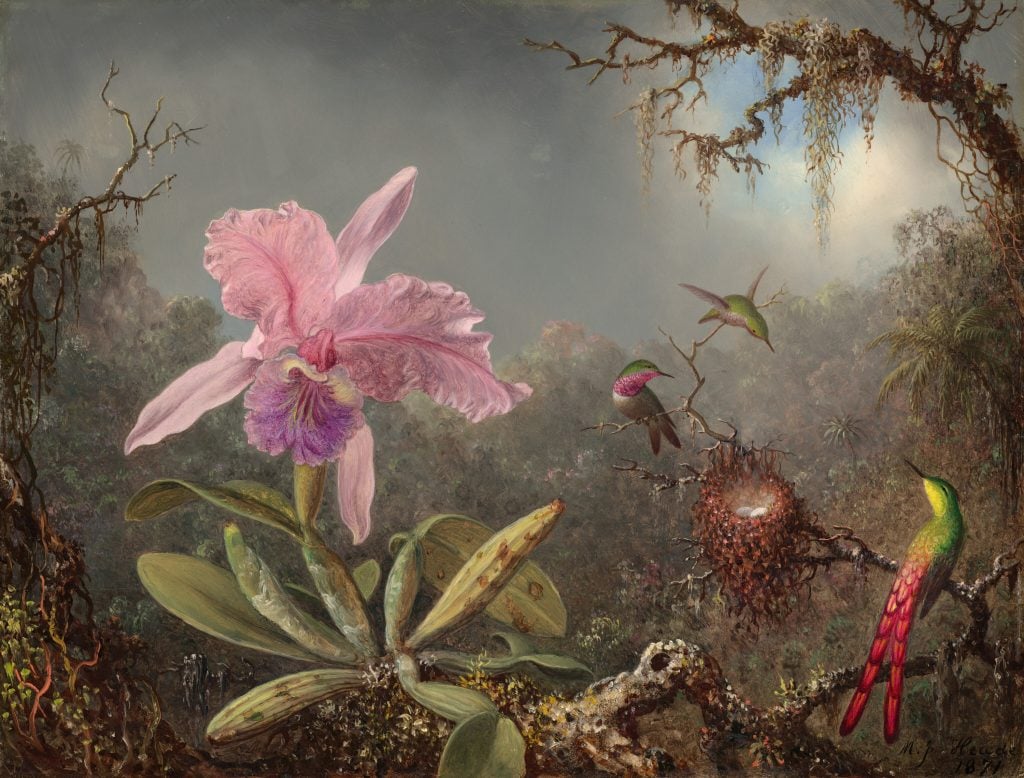
Martin Johnson Heade, Cattleya Orchid and Three Hummingbirds (1871). Photo by Heritage Art/Heritage Images via Getty Images.
Around the same time North was traveling the British territories, the Hudson River School painter Martin Johnson Heade was expanding the landscape tradition of Frederic Edwin Church and his compatriots into the humid tropics of Central and South America. Alongside depictions of hummingbirds (revealed later to be painted from preserved skins), his 1860s-70s canvases are filled with dramatic, idealized representations of native orchids. Through these images, Heade foisted an exoticizing Western vision onto an Indigenous landscape—a concern that has since been explored by several contemporary artists, including most recently by the Dominican-born Bony Ramirez.
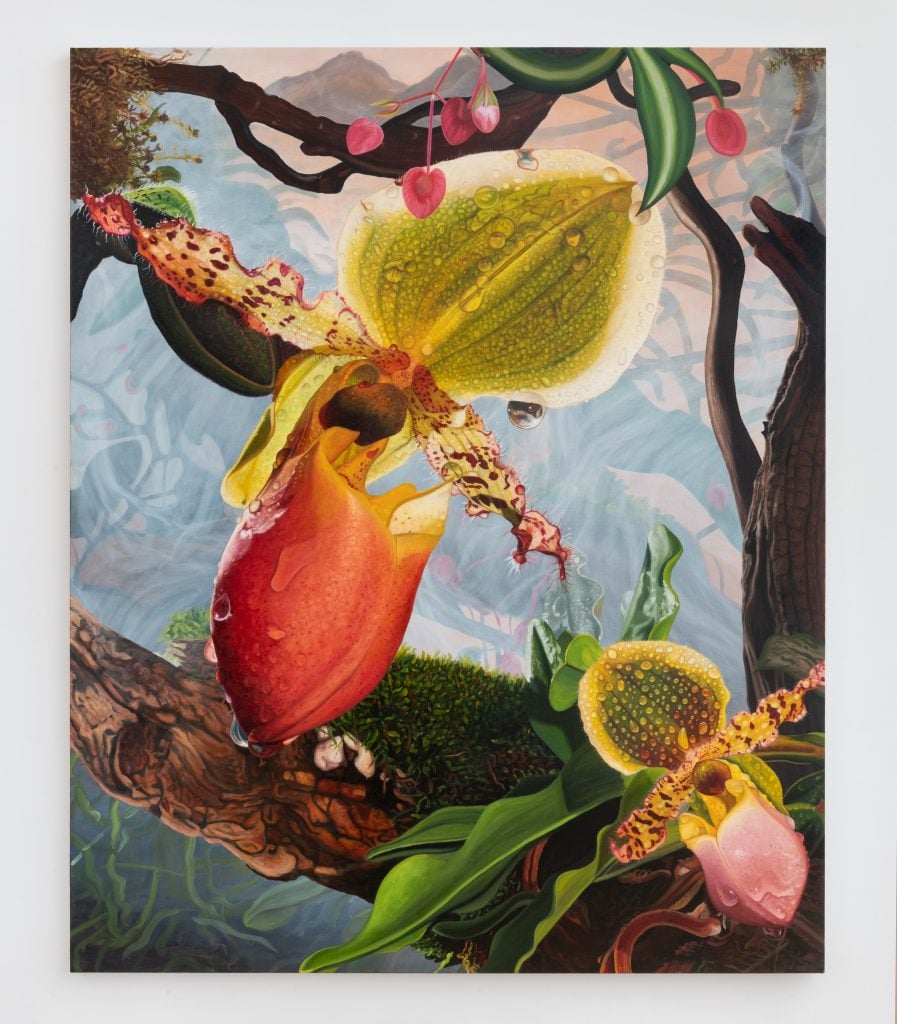
Kate Bickmore, Nature v. Nurture (after Madonna and Child) (2024). Courtesy of the Artist and CHART. Photo: Adam Reich.
Conversely, Bickmore takes pains to paint each of her orchids as singular beings, not examples of a romanticized archetype. Since the flowers in her work are all based on specific specimens she studied in person, it makes sense that she adopts the language of portraiture when discussing them. “I want to depict every freckle, vein, scar, and mark—all the things that make that individual plant unique, rather than a ‘stock image’ of a plant,” Bickmore says. “At that scale, too, the plants start mimicking parts of the human body.” This desire stems from her interest in restoring agency to flowers—an agency denied them by 19th-century painting traditions.
Bickmore also sees special significance in the way orchids have evolved to attract pollinators: by mimicking the appearance and pheromones of different insects. “Their bodily-ness comes across so much more on a larger scale,” she says of the flowers, noting that they “often look like human sexual organs” and are integral to reproduction. But their essential “queerness” is also on view, she adds: “Many of the visual signifiers we often use to ‘gender’ things are limitless in plants—they are at once yonic and phallic and everything in between.” In this way, her paintings counter the nationalist masculinity that predominated in the paintings of Heade and other Western naturalists of the 1800s.
The Rafflesia of Sir Stamford Raffles
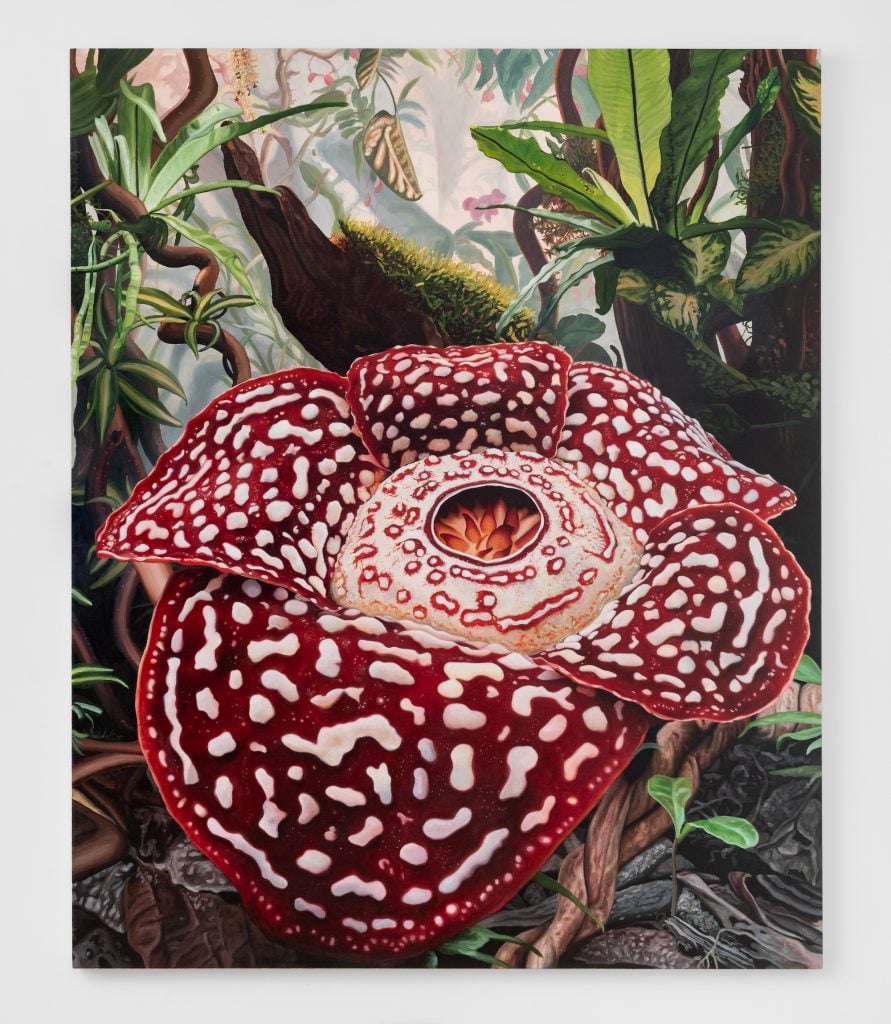
Kate Bickmore, Emergence (from the Underground) (2024). Courtesy the Artist and CHART. Photo: Adam Reich.
Several of Bickmore’s thematic foci—the importance of scale and direct botanical experience, the foregrounding of studio manipulation, and the recognition of floral individuality—coalesce in her portrayal of the Rafflesia, the centerpiece of the artist’s trip through Borneo. Also known as the stinking corpse lily, this flower is a parasitic plant native to Southeast Asia that lacks leaves, stems, and roots; it also blooms only in the wild, making firsthand viewing essential.
The plant’s Western scientific name is indebted to Sir Stamford Raffles, the British colonial official often credited as the founder of contemporary Singapore (as well as the namesake of the exclusive international hotel chain Raffles). But Bickmore’s oversized portrait of this species again asserts the subject’s uniqueness, not its tokenization. “The Rafflesia I depicted in the show isn’t just the ‘idea’ or stock image of a Rafflesia, it is a portrait of the Rafflesia I met in Borneo,” she says.
Yet here too the artist has embellished her work to add conceptual heft. Upon close viewing, her Rafflesia’s petals are dotted by white marks that covertly form the 12 constellations of the zodiac. It is a subtle symbol reinforcing her reverence for the flowers she paints, seeing them as singular beings imbued with cosmic features and an evergreen cultural relevance far greater than the legacy of manmade taxonomies and Victorian painting traditions.